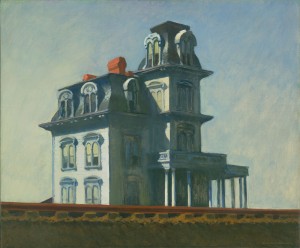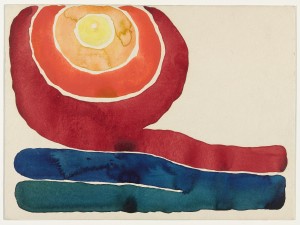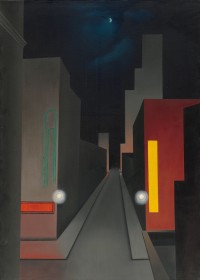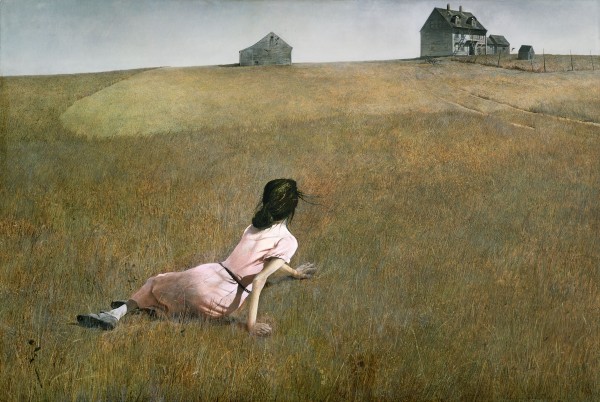LAST CHANCE: MoMA travels from Hopper to O’Keeffe in ‘American Modern’

NEW YORK — The Museum of Modern Art’s dedication to American art has been called into question over the years. In fact, the museum makes reference to the perceived bias in the exhibition catalogue of its new show American Modern: Hopper to O’Keeffe. However, what this compilation of classics proves is that MoMA is a great exhibitor of American art in many different forms and styles; don’t’ believe the critics. The understated pleasures of many of these pieces speak volumes to the museum’s dedication to the big names of the 20th century (Georgia O’Keeffe, Edward Hopper, Gerald Murphy and Andrew Wyeth) and lesser-known artists who offer equal pleasures and as many ponderances.
The Hopper pieces in the exhibition are especially magnificent. His “House by the Railroad” features a stately mansion lit from behind, in almost a haunted fashion, and its foreground is cut off by a railroad, obstructing the house’s bottom third. There’s a lot going on in the simple painting. Hopper could be speaking about the continued industrialization of the United States, where homes are bedfellows to railroad tracks. There’s also an ominous lonesomeness to the painting: No one is home, and the tracks cover any evidence of greenery or life. This could very well be a funeral home.

“Night Windows,” also by Hopper, offers a voyeuristic view into an apartment building at night. A woman, perhaps getting ready for bed, is mostly hidden but still on view in the middle window. She is flanked by other windows, all offering a lighted glance into a world we’re unable to experience.
The best Hopper piece is the large oil on canvas known as “New York Movie.” Again, that trademark loneliness is present, this time focused on a movie theater usher contemplating in the hallway of a darkened movie house. She’s dressed in her uniform, leaning her chin on a hand. What she’s thinking about is uncertain, but the fact that she’s focusing her thoughts is evident.
I found myself most surprised by Hopper’s “Night Shadows,” a small etching from 1921. A man walks at night on a street devoid of life. He approaches the shadow of a streetlamp, a little hunched over, perhaps heading home after a night at the bar. Such inferences are always good fun in Hopper’s pieces.
Ben Shahn is represented with “New York,” a photograph, and “Handball,” a painting on paperboard. We’re given a backward view of friends playing in the streets. They are nameless and faceless, driven by their dedication to the game. Their lack of definition gives them a sense of equality and timelessness.
O’Keeffe, perhaps the most famous painter included in American Modern, has the brilliantly colorful “Evening Star, No. III” on display, plus “Abstraction Blue,” a large painting cut in half by a broadening line in the middle of what looks like a bulb of a blue flower.

The most interesting of O’Keeffe’s pieces is “Train at Night in the Desert,” an earlier painting where a train’s smoke overpowers the tiny locomotive heading through a featureless landscape. O’Keeffe also turns up in a few photographs from Alfred Stieglitz, or at least her hands show up, clutching a horse skull, among other items.
There’s something wonderfully tabloid about George Bellows’s “Dempsey and Firpo,” as if he has captured the sport of boxing like a great piece of sports journalism. The pugilist in the ring has knocked down his opponent, and he’s holding his position and stance, almost showing off beneath the glow of the lights.
Other highlights: Paul Cadmus’s “Greenwich Village Cafeteria,” a busy oil on canvas depicting people on the move to enjoy some food and good times; Paul Outerbridge’s iconic photograph of an “Ide Collar;” Murphy’s “Wasp and Pear,” a piece that begs a multi-minute stare because of its sliced-open view of a green pear and alien-looking wasp; and the many works of Charles Burchfield, which take up an entire exhibition wall. Burchfield’s “The Night Wind” from 1918 is a superb meditation on a small village ravaged by the elements.
The nice combination of photographs, sculpture and paintings makes American Modern a full portrait of MoMA’s American dedication. There are a few common themes that jump out: pastoralism, workers’ rights, factories and household items as central subjects. Nothing brings this emphasis through quite like Wright Morris’s “Farmhouse in Winter, near Lincoln, Nebraska,” an eerily effective photograph of a solitary farmhouse in a winterized field.
One of the distinct pleasures of the exhibition, which concludes Jan. 26, is seeing a few of the simplistic paintings from Jacob Lawrence’s Migration Series. The paintings show people and their circumstances, all outlining the African-American community’s travels during this important historical era. A full exhibition of Lawrence’s work would be a solid addition to any museum’s schedule. At MoMA, the story of the migration felt oddly incomplete, as if the viewer is only privy to a few scenes in a much longer movie.

Final highlights to consider: Louis Lozowick’s “Crane,” a lithograph depicting a monstrously sized piece of machinery; George Ault’s “New Moon, New York,” a painting where the street lamps look like cars’ high beams; and the work of Walker Evans, subject of another MoMA exhibition and one of America’s finest photographers.
Leave at least 60-90 minutes for the entire exhibition, and tack on an additional 10 minutes solely for Wyeth’s “Christina’s World,” a MoMA gem. With the title character lying hopelessly and helplessly on the outskirts of a field, looking toward a house in apparent mourning or remembrance of something sad, “Christina’s World” is a piece large in size and gargantuan in effect.
By John Soltes / Publisher / John@HollywoodSoapbox.com
-
Click here for more information.

